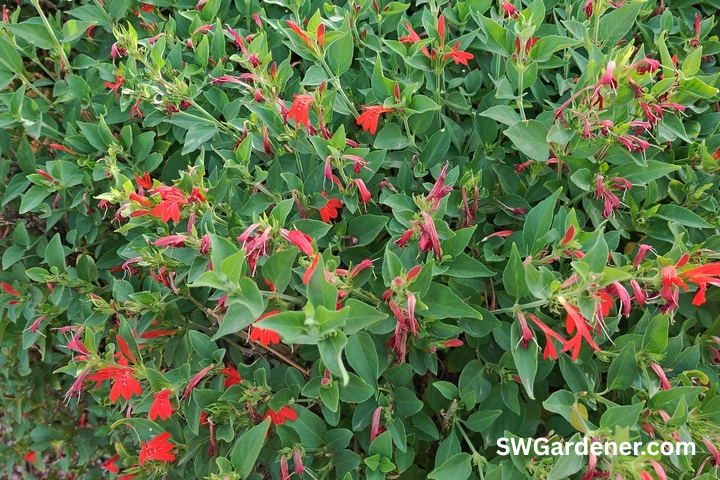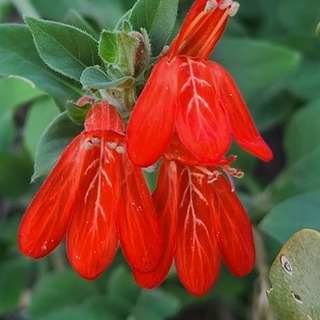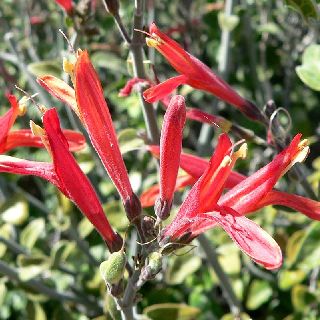Red justicia is an unusual native shrub that prefers part shade to sun and needs a moderate amount of water. Your reward for providing it the right conditions will be glowing flowers that are wildly attractive to hummingbirds. Here’s everything you need to know about growing this colorful Sonoran Desert native in this complete care guide.

Red justicia (Dianthera candicans) is a medium size shrub with bright green leaves that contrast beautifully with red-orange tubular flowers that nearly glow.
It many ways, this plant is an unusual Arizona native. It prefers part shade to sun and its leaves are soft and fuzzy — no prickers, thorns, or irritating hairs. It needs a moderate (rather than low) amount of water. This makes it an ideal plant to grow in the dappled shade under a tree or near other moderate water use plants.
Red justicia blooms on and off much of the year, providing nectar for hummingbirds when there isn’t much else available. It is also a larval host for several butterfly species.
Why I Like This Plant
- Red flowers almost all year
- Attractive bright green leaves
- Attracts hummingbirds, butterflies
- No thorns, low litter
- Low maintenance
Things to Watch Out For
This plant needs different care than most desert shrubs. Don’t plant this where it gets blasted by full sun, and give it a moderate rather than low amount of water.
The Arizona Native Plant Society calls this plant Arizona water willow, which gives you a big hint about its water needs. In its native habitat, it grows in moist, rocky canyons in Mexico and southern Arizona.
Optimal Growing Conditions
If you’re thinking of adding a red justicia to your garden, you need to find a suitable place that will keep your plant healthy and looking good… while minimizing maintenance for you.
Here are the key factors to keep in mind.
Temperature
Red justicia should be grown in USDA Hardiness Zone 9. It’s a heat loving plant that survives cold down to the twenties. Foliage may be damaged when temperature dips below 25℉, but growth rebounds in the spring.
Sun Exposure
Red justicia prefers part shade or full shade to full sun. And unlike some desert plants that tolerate full shade but stop blooming, it will continue to bloom in full shade. The more sun this plant gets, the more water it needs.
Size and Growth Rate
Red justicia is a fast growing shrub that typically reaches a size of 4 feet tall by 5 feet wide.
Plants bloom spring through fall but flower most heavily in the spring. With mild winters, it may flower on and off throughout the year.

Soil
Red justicia grows well in most native soil, provided it’s well-draining.
Other Location Considerations
Red justicia can be grown in a large container. This allows you to move it as necessary to keep it out of full sun. Grow one as a patio plant to enjoy the hummingbird activity.
Red Justicia:
The Essentials
| Common Name | Red justicia |
| Scientific Name | Dianthera candicans |
| Origin | Arizona, Mexico |
| Plant Type | Semi-deciduous shrub |
| USDA Zone | Zone 9 |
| Cold Hardiness | To 25℉ |
| Flower Color | Red-orange |
| Flower Season | Spring, summer, fall |
| Mature Size | 4’ high x 5’ wide |
| Growth Rate | Moderate |
| Sun Tolerance | Part, full shade |
| Water Needs | Moderate |
| Pests & Diseases | None |
| Garden Friendly | No thorns, non-toxic |
| Wildlife | Attracts butterflies, hummingbirds Rabbit resistant |
How to Plant
The rule of thumb when planting any shrub in the desert is to dig a hole three times as wide as the root ball but no deeper. Amending the soil is not recommended. Counterintuitively, backfilling with the same native soil you just dug up helps your plant develop a stronger root system.
When to Plant
The best time to plant red justicia is in the fall. This gives your shrub three seasons to grow roots and get established before the following summer.
The second best time is in spring, the earlier the better. This still gives your plant time to get established before the intense heat of June arrives.
How to Care for Red Justicia
Whether you’ve recently planted a red justicia or have an existing plant in your yard, here’s how to take care of it to keep it healthy and looking its best.
How to Water New Plants
Once you’ve got your shrub in the ground, watering is your most immediate concern. Here is the recommended watering schedule for new shrubs planted in the spring or fall.
| Weeks 1 & 2 | Every 3 – 4 days |
| Weeks 3 & 4 | Every 5 – 7 days |
| Weeks 5 & 6 | Every 7 – 10 days |
| Weeks 7 & 8 | Every 10 – 14 days |
After week 8, gradually extend the time between waterings.
How to Water Established Plants
As your shrub gets established, there are two watering factors to consider.
- First is how often to water. This will vary with the seasons.
- Second is how much water to give your shrub with each watering. This depends on the current size of your plant.
To determine the ideal watering schedule for any desert shrub, you’ll find everything you need to know, including easy-to-use charts, at How to Water Desert Shrubs: How Often? How Much? Since red justicia is a moderate water use shrub, use the “high water use” schedule.
Should You Fertilize?
You don’t have to fertilize red justicia, but you can. The Arizona-Sonora Desert Museum suggests fertilizing a few times per year. This will help ensure optimal blooms.
How to Prune
Red justicia doesn’t need regular pruning. Remove any frost damage in early spring and lightly trim to shape or reduce legginess in the late spring.
Don’t Confuse Red Justicia With…
Red justicia is sometimes confused with chuparosa (Justicia californica). These plants have a lot in common. Both are medium-size, Sonoran Desert native shrubs that have tubular red flowers that hummingbirds love.

However, there are some notable differences. Chuparosa has small gray-green leaves and sparse foliage. It prefers full sun, survives on little water, and is often leafless since it loses its leaves when facing drought or cold. It’s the ultimate hummingbird magnet — it’s name means hummingbird in Spanish.
It is a wilder-looking plant, so red justicia makes a good alternative if you’re looking for a plant that hummingbirds love but has a more manicured look.
Plant Lover Facts
Red justicia also goes by the common names red jacobiana, Chihuahua honeysuckle, and Arizona water willow, but these are not often used.
Although it is still almost always referred to as Justicia candicans, it’s currently accepted scientific name is Dianthera candicans. This makes its common name red “justicia” confusing. Perhaps one day, the more apt name “Arizona water willow” will catch on.
Did you enjoy this article?
Sign up for our weekly newsletter
where you’ll find more great info on creating &
maintaining a beautiful, carefree desert landscape.
Author Bio
Deane Alban is the creator of Southwest Gardener. She is a science writer with a bachelor’s degree in botany from the University of South Florida. Gardening is her lifelong passion. She’s been gardening in Tucson for over 15 years.

